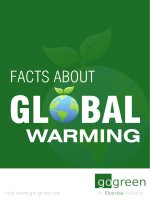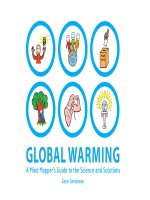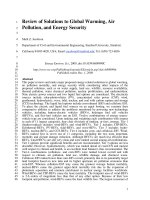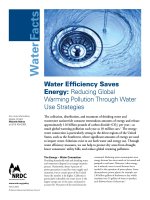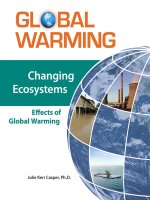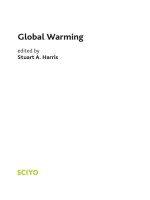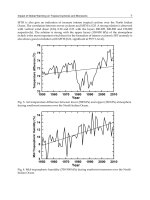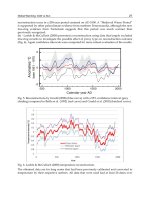Introductory Climate Science; Global Warming Explained Terry Sloan
Bạn đang xem bản rút gọn của tài liệu. Xem và tải ngay bản đầy đủ của tài liệu tại đây (11.17 MB, 202 trang )
TERRY SLOAN
INTRODUCTORY CLIMATE
SCIENCE; GLOBAL
WARMING EXPLAINED
Download free eBooks at bookboon.com
2
Introductory Climate Science; Global Warming Explained
1st edition
© 2016 Terry Sloan & bookboon.com
ISBN 978-87-403-1408-3
Peer review by Michael J. Hambrey, Emeritus Professor of Glaciology,
Aberystwyth University
Download free eBooks at bookboon.com
3
INTRODUCTORY CLIMATE SCIENCE;
GLOBAL WARMING EXPLAINED
CONTENTS
CONTENTS
Foreword
8
Preface
9
1
Man-Made Global Warming – an overview
11
1.1
Introduction
11
1.2
Why do greenhouse gases cause global warming?
16
1.3
A simple picture of man-made global warming
18
1.4
The more complete picture
21
1.5
Conclusion
23
2
Drivers of the Climate
26
2.1
The difference between weather and climate
26
2.2
Overview of the climate
27
2.3
Heat energy transfer
32
2.4
The Sun
34
2.5
Warming of the Earth’s surface due to greenhouse gases.
37
2.6
Conclusion
41
www.sylvania.com
We do not reinvent
the wheel we reinvent
light.
Fascinating lighting offers an ininite spectrum of
possibilities: Innovative technologies and new
markets provide both opportunities and challenges.
An environment in which your expertise is in high
demand. Enjoy the supportive working atmosphere
within our global group and beneit from international
career paths. Implement sustainable ideas in close
cooperation with other specialists and contribute to
inluencing our future. Come and join us in reinventing
light every day.
Light is OSRAM
Download free eBooks at bookboon.com
4
Click on the ad to read more
INTRODUCTORY CLIMATE SCIENCE;
GLOBAL WARMING EXPLAINED
CONTENTS
3
The Atmosphere
44
3.1
Structure of the atmosphere
44
3.2
Variation of pressure with altitude
46
3.3
Variation of temperature with altitude in the troposphere – the lapse rate 48
3.4
The Stratosphere
49
3.5
The ozone layer
51
3.6
The atmospheric electric circuit
52
3.7
Conclusions
54
4
The Principles of Cloud Formation
57
4.1
Introduction
58
4.2
Constituents of clouds.
59
4.3
Surface Tension
61
4.4
Vapour pressure
62
4.5
The formation of cloud droplets from CCN
63
4.6
The effect of electric charge on the formation of water droplets
67
4.7
Cosmic rays and cloud formation.
69
4.8
The hypothesis that ionization affects cloud formation
72
4.9
Attempts to corroborate the hypothesised connection between
4.10
cosmic rays and the climate
72
Conclusions
75
Appendix 4.1 The pressure inside a curved surface due to surface tension 76
Appendix 4.2 Derivation of the Kelvin Formula
77
5
Energy circulation and monitoring
83
5.1
The seasons
84
5.2
Energy circulation
84
5.3
Coriolis acceleration
85
5.4
The wind direction
86
5.5
Atmospheric circulation
87
5.6
The circulation of the oceans
89
5.7
Monitoring of the oceans and atmosphere.
93
5.8
The rising sea level
96
Download free eBooks at bookboon.com
5
INTRODUCTORY CLIMATE SCIENCE;
GLOBAL WARMING EXPLAINED
CONTENTS
6
Absorption of infra-red radiation
100
6.1
Atomic spectra
101
6.2
Molecular spectra
102
6.3
The broadening of spectral lines
104
6.4
Absorption of radiation
106
6.5
The absorbance of the atmosphere
110
6.6
Conclusions
110
Appendix A6.1 Semi-classical argument to justify equation 6.2
110
Appendix A6.2 Doppler broadening of spectral lines –
proof of equation 6.4
111
7
Climate Models
114
7.1
Introduction
114
7.2
Warming of the Earth’s surface by greenhouse gases.
114
7.3
The effect of increasing carbon dioxide levels – a simple picture
116
7.4
More complete models of the climate
122
7.5
Radiative Forcing (RF)
123
7.6
Conclusions
127
Appendix A7 Derivation of equation 7.2
128
8
Measurement of the average global temperature
133
8.1
Introduction
134
8.2
Determination of the average temperatures from measurements
on the Earth’s surface
135
8.3
Measurements from space
141
8.4
Comparison of satellite and surface measurements of the global
average temperature
143
Appendix A8 Basic statistics
147
9
History of the Earth and its climate
158
9.1
Introduction
159
9.2
Formation of the Solar System
159
9.3
The Early Earth
162
9.4
The Phanerozoic Eon starting about 540 million years ago
166
9.5
The last several million years
169
9.6
Conclusion
179
Appendix A9.1 Fourier Analysis
180
Download free eBooks at bookboon.com
6
INTRODUCTORY CLIMATE SCIENCE;
GLOBAL WARMING EXPLAINED
CONTENTS
10
The Intergovernmental Panel on Climate Change (IPCC)
186
10.1
Introduction to the IPCC
186
10.2
Climate Forcings
187
10.3
Components of the scientific task
187
10.4
Climate Modelling
188
10.5
The ‘balancing-out process’
189
10.6
The IPCC Review Process
190
10.7
The IPCC’s caution
191
10.8
The IPCC report AR5
191
10.9
Governmental Responses to the IPCC
193
11
Epilogue
197
Endnotes
202
Download free eBooks at bookboon.com
7
INTRODUCTORY CLIMATE SCIENCE;
GLOBAL WARMING EXPLAINED
FOREWORD
FOREWORD
Climate Change is one of the burning issues of the day (no pun intended) and it is crucial
to understand the nature of the reason or reasons for the undoubted average Global
temperature change over the past century, or so. A number of text books on the topic
have appeared, written in the main by meteorologists, and the conclusion is invariably that
man-made emissions are responsible. However, there have been criticisms from some nonmeteorologists, that their analyses are, if not lawed, seriously suspect. his is where the
present book comes in. It is written by a distinguished elementary particle physicist who
has no axe to grind and who is keen to go back to basics and analyse the physics involved.
To say that the book is comprehensive is an understatement. It ranges from the basic
science in question, to such topics as the History of the Solar System and the work of the
Intergovernmental Panel on Climate Change. Although written as an undergraduate text,
and indeed the topics have served that purpose, it can be read by most people who have
some knowledge of science; a summary should be prescribed reading for all politicians who
have responsibility for the Earth's continued well being.
(Sir) Arnold Wolfendale FRS, 14th Astronomer Royal and former President of the Institute
of Physics and the European Physical Society.
Download free eBooks at bookboon.com
8
INTRODUCTORY CLIMATE SCIENCE;
GLOBAL WARMING EXPLAINED
PREFACE
PREFACE
his book is intended to explain the basic principles of the science which lies behind the
subject of man-made global warming. It is based on a series of lectures given as an optional
course for physics undergraduates at Lancaster University. he course was named “he Physics
of Global Warming”. As beits a scientiic study of a subject, quantitative treatments are
given and the book contains algebra and formulae. Nevertheless it should be possible for a
person with a non-mathematical background to read through these formulae and achieve
an understanding of why the increasing concentration of greenhouse gases arising from
burning fossil fuels leads to global warming. he term greenhouse gases here means mainly
carbon dioxide (CO2), methane (CH4) and oxides of nitrogen.
My background is in particle physics and I became interested in climatology when it was
hypothesised by some scientists that cosmic rays were the main cause of global warming rather
than increasing greenhouse gas concentrations. Attempts were then made by myself and coworkers, all particle or cosmic ray physicists, to corroborate the hypothesis. he conclusion
of this work was that while cosmic rays must have some efect on global warming via cloud
formation, the efect is too small to be detected and therefore only plays a minor role.
Subsequent to this I became interested in trying to understand why changes in the small
concentrations of greenhouse gases could lead to signiicant global warming. Having achieved
at least a qualitative understanding of this, the course referred to above was designed and
given. Another reason to be interested in this subject stemmed from reading accounts in
the popular press and on the internet which often deny that man-made global warming is
occurring. I felt it necessary to gain enough understanding to be able to judge the quality
of such accounts. his book aims to allow the reader to be able to separate the science from
the pseudo-science which surrounds this subject.
Download free eBooks at bookboon.com
9
INTRODUCTORY CLIMATE SCIENCE;
GLOBAL WARMING EXPLAINED
PREFACE
Nowadays, the hypothesis that increasing concentrations of greenhouse gases in the
atmosphere cause global warming is almost universally accepted as the paradigm among
expert climatologists and it is accepted by all learned societies of the World. he organisation
responsible for overseeing and reviewing all the scientiic literature which leads us to this
conclusion is the Intergovernmental Panel on Climate Change (IPCC). his is a panel of
many hundreds of the World’s foremost experts on climate science. he work of the panel
is described in Chapter 10 and is summarised in 5 publically available Assessment Reports
(AR) which have been released so far. he irst AR is labelled FAR, the second SAR, third
TAR, the fourth AR4 and the latest one released in 2014 is AR5. hese reports, running
to thousands of pages, are all available on the World Wide Web at />he reader is referred to these reports for further details of the theories and measurements
and the references to the scientiic papers where they are described. his book is meant to
serve as a starting primer.
Chapter 1 of the book gives a qualitative (i.e. non-mathematical) overview of the basic
reasons why our increased use of fossil fuels will lead to global warming and ultimately a
change to the climate. he subsequent chapters describe the main features of the climate
and the principles of the science which leads to these conclusions.
In the journey to achieve the understanding to permit me to write this book I have been
helped by many people. I am particularly indebted to my colleagues Professor Anatoly
Erlykin and Professor Sir Arnold Wolfendale for many stimulating discussions. I am also
indebted to Professor Fred Taylor of Oxford University for his book Elementary Climate
Science from which I learned much and for his help to further my understanding of the
subject. I am grateful also to Professors Joanna Haigh and Giles Harrison for help on many
topics. I also thank Professor Sir John Houghton for his assistance in writing Chapter 10.
Particular thanks go to Professor Mike Hambrey for his suggestions and his critical reading
of the manuscript. Finally I thank my Wife, Jean, for her love and encouragement to carry
on even when writing became a chore.
T. Sloan (April 2016).
Download free eBooks at bookboon.com
10
INTRODUCTORY CLIMATE SCIENCE;
GLOBAL WARMING EXPLAINED
1
MAN-MADE GLOBAL WARMING – AN OVERVIEW
MAN-MADE GLOBAL WARMING –
AN OVERVIEW
In this chapter a brief and qualitative overview is given of the science underlying man-made
global warming from the increased concentration of carbon dioxide (CO2) and other socalled greenhouse gases in the atmosphere. hese have arisen from the increased burning of
fossil fuels since the onset of industrialisation in the 19th century. he explanations in this
chapter are covered more fully and quantitatively in the remainder of the book.
A simple model is briely outlined in the chapter. his simple picture ignores all the many
features of the climate other than the efects of increasing levels of greenhouse gases. It
serves to show that global warming can be understood without the need for the more
complicated models used by climate scientists which are fully documented in the reports of
the Intergovernmental Panel on Climate Change (IPCC). However, to obtain a complete
and accurate picture, all the features need to be accounted for and these are included in
the more complicated models.
We start with a deinition of what we mean by the climate. he climate is a long term average
over all the large variety of weather variations. he weather represents the luctuations about
this average. For example, the Tropics have a climate which is warm and balmy; however,
from time to time a snow storm can occur. he former (what you expect) is the climate
but the latter (the luctuation about the average) is the weather. A mnemonic is that the
“climate is what you expect while the weather is what you get”.
1.1
INTRODUCTION
Measurements of the average global surface temperature show a rising trend since the 19th
century. his is what we term global warming. It is extremely likely that the causes are due
to the increasing concentrations of greenhouse gases in the atmosphere from the burning
of fossil fuels such as coal, gas and oil. he small probability of doubt in this statement
will be discussed in later chapters. hese fuels have been produced and used in increasing
quantities since industrialisation. Such warming is leading to changes to the climate. he
main greenhouse gas is carbon dioxide whose concentration has grown from 280 parts per
million (ppm) in the early 19th century when large scale industrialisation began to over
400 ppm now (2016).
Download free eBooks at bookboon.com
11
INTRODUCTORY CLIMATE SCIENCE;
GLOBAL WARMING EXPLAINED
MAN-MADE GLOBAL WARMING – AN OVERVIEW
In this chapter a simpliied overview of the reasons for this man-made global warming is
given. his simpliied overview summarises the book. he summary omits the mathematics
necessary to master fully the picture of increasing greenhouse gas concentrations leading to
man-made climate change. It rather gives an overview of the principles involved which, it is
hoped, will make the application of mathematical details to the argument in later chapters
easier to follow.
Although the vast majority of expert climate scientists accept that the emission of greenhouse
gases leads to global warming and with it climate change (IPCC AR5 2013), there are some
scientists and non-scientists who deny the connection. he vast majority of these are not
experts on climate science. Man-made climate change denial will be dealt with in Chapter 11.
It seems clear that to burn of the fossil fuels laid down over hundreds of millions of years
in a period of a few hundred years must lead to serious consequences for the atmosphere.
Such burning is efectively a slow-motion explosion.
A reason for denial is often given as mistrust of computer models. In this book a simple
picture is derived which gives the irst order principle on which these models are based.
Such a basic picture is readily understandable. Hence we show that there is no need for
complicated computer models to understand the basic science behind man-made global
warming or anthropogenic global warming (AGW) as it is called. he room for doubt will
be discussed in a later chapter.
Figure 1.1 shows the mean global surface temperature anomaly (i.e. diference from the
1961–1990 average global temperature) as a function of time. he curves are the results of
diferent analysis techniques and they have been combined with the temperature records
taken from thermometer readings after 1850. Roughly 1000 years ago the temperature was
somewhat lower than today and this is sometimes referred to as the Mediaeval Warm Period.
he temperature decreased to roughly 1°C cooler than today 300 years ago and this is
sometimes referred to as the Little Ice Age.
Download free eBooks at bookboon.com
12
INTRODUCTORY CLIMATE SCIENCE;
GLOBAL WARMING EXPLAINED
MAN-MADE GLOBAL WARMING – AN OVERVIEW
Figure 1.1 The mean reconstructed global temperature anomaly over the last 2000 years against time from
various reconstructions in the (a) Northern (b) Southern Hemsipheres and (c) Global (Source IPCC AR5 2013,
see this reference for the details of the different reconstructions). The accuracy can be judged from the differences
between the different reconstructions.
Fig 1.1 and the reconstruction of Marcott et al 2013 (available at atlantic.
com/static/mt/assets/science/marcott-B-CD.jpg) shows that during the last 10000 years or
so the mean global temperature has been relatively stable compared to the large decrease
seen in the earlier ice age (see Chapter 9). During this epoch of stable climate mankind
has progressed from being a hunter-gatherer into the present society of the 21st century. In
other words the stable climate has allowed civilisations to lourish.
Download free eBooks at bookboon.com
13
INTRODUCTORY CLIMATE SCIENCE;
GLOBAL WARMING EXPLAINED
MAN-MADE GLOBAL WARMING – AN OVERVIEW
Corroboration of the sudden 20th century temperature rise is found in the area of sea ice
in the Arctic which is observed to be shrinking due to the warming as shown in Chapter 5
(see igure 5.8b). Additionally, the mean thickness of the Arctic sea ice has been observed to
have almost halved between 1970 and 2010 (Lindsay and Schweiger 2015). Conversely,in
the Antarctic the sea-ice area has been increasing. his is thought to be due to complex
processes from global warming such as the increased delivery of glacial meltwater produced
by the rising temperatures. he meltwater is less dense than sea water so that it loats on the
sea surface where it freezes more easily than salt water due to its higher freezing temperature.
his freezing accounts for the increased Antarctic ice sheet. Further corroboration comes
from glaciers all over the World from the Tropics to Polar regions which are shrinking at an
accelerating rate because of rising temperatures (see Chapter 5, igure 5.9 taken from Llovel
et al 2014). he shrinking of a glacier is illustrated in igure 1.2. here are a few exceptions
of growing glaciers. hese occur where the increased precipitation falling as snow, expected
from global warming, more than compensates for the melting due to rising temperatures.
Doubters point to the increase in Antarctic sea ice and the few growing glaciers to justify
their view, ignoring the good scientiic reasons for such efects.
360°
thinking
.
Discover the truth at www.deloitte.ca/careers
Download free eBooks at bookboon.com
14
© Deloitte & Touche LLP and affiliated entities.
Click on the ad to read more
INTRODUCTORY CLIMATE SCIENCE;
GLOBAL WARMING EXPLAINED
MAN-MADE GLOBAL WARMING – AN OVERVIEW
1996
2009
Figure 1.2 Kongsbreen, a tidewater glacies in Svalbard in the Norwegian Arctic, in 1996 and 2009. The
person is standing in exactly the same position in each, and the mountains in the background serve as
reference points. In the 1996 image glacier ice with its prominent moraine (the line of debris) fills the
background. By 2009 a marine embayment has encroached into the glacier from the right. Note also how
the mountains are more prominent in 2009, the result of substantial thinning of the glacier. (Photo, by kind
permission of M. Hambrey). For more illustrations of melting glaciers see />Retreat_of_glaciers_since_1850.
Download free eBooks at bookboon.com
15
INTRODUCTORY CLIMATE SCIENCE;
GLOBAL WARMING EXPLAINED
MAN-MADE GLOBAL WARMING – AN OVERVIEW
he main reasons for the sudden warming is widely believed to arise from the increase in
the socalled greenhouse gas concentrations in the atmosphere. his name is applied since
these gases act as a warming agent in the atmosphere as we shall discuss below. he increase
in the concentrations of greenhouse gases since industrialisation is illustrated in igure 1.3.
Figure 1.3 Illustrations of the rapid increase in various greenhouse gases since industrialisation began in
1800 (IPCC TAR).
1.2
WHY DO GREENHOUSE GASES CAUSE GLOBAL WARMING?
All bodies radiate energy which is carried away by electromagnetic radiation. For example
when you feel the warmth from a heater your body is sensing the emitted radiation. he
wavelength and intensity of such radiation depends on the temperature of the body. At
low temperatures the radiation is mainly in the invisible infra-red region of the spectrum.
he wavelength becomes shorter as the temperature increases. he intensity of the radiation
increases rapidly as the temperature of the body increases (as the fourth power of the absolute
temperature). hus the sun at a surface temperature of 5780K radiates in the visible part of
the spectrum. However, a warm water radiator at a temperature of order 340K (70°C radiates
via infra-red radiation which can be felt on standing next to such a radiator (see endnote 1
page 202). To understand this, think of a block of iron put in a ire. If removed quickly it
does not glow and one can only feel the heat radiated (via the infra-red radiation). If left
longer in the ire the iron begins to glow with a dull red colour (red is a long wavelength
visible radiation). If left longer still the iron glows when it becomes white hot i.e. all colours
of the rainbow are being emitted as well as some infra-red radiation.
Download free eBooks at bookboon.com
16
